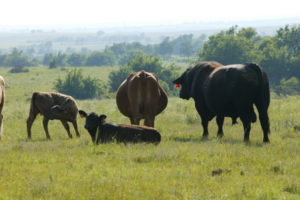A 9 Week Mating Period?
23 August 2017 At a recent monitor farm meeting they were setting up a trial to look at using oestrus synchronisation to bring forward the last calving cows in the herd. Last year the bull ran with the cows for just 10 weeks so the group consisted of cows who last year became pregnant in the third cycle. The synchronisation system selected was discussed and certainly appears positive – but time will tell. However this year the bull will still be kept in for 9 weeks ie 3 cycles. This almost certainly means that there will again be some late calvers again next year. These will need to be synchronised to bring them forward and reduce the number of barren cows, repeating itself year on year. To me the simplest approach is to synchronise the late calvers this year and take the bull out earlier, setting an eventual target of a 6 rather than a 9 week bulling period.
At a recent monitor farm meeting they were setting up a trial to look at using oestrus synchronisation to bring forward the last calving cows in the herd. Last year the bull ran with the cows for just 10 weeks so the group consisted of cows who last year became pregnant in the third cycle. The synchronisation system selected was discussed and certainly appears positive – but time will tell. However this year the bull will still be kept in for 9 weeks ie 3 cycles. This almost certainly means that there will again be some late calvers again next year. These will need to be synchronised to bring them forward and reduce the number of barren cows, repeating itself year on year. To me the simplest approach is to synchronise the late calvers this year and take the bull out earlier, setting an eventual target of a 6 rather than a 9 week bulling period.
Why?
Providing cows are in reasonable condition or gaining condition and have not had a difficult calving they will normally begin cycling around 5 weeks after they have calved. However this first heat tends to be less fertile (as the womb has not been “flushed out” and is not sterile). In comparison the second heat, which generally occurs 8 weeks post calving, tends to be highly fertile.
The following diagram shows the impact this “timetable” has for cows calving at the start of each 3 week cycle.
Effect Of Date Of Calving On Mating
| Start of Calving | Start of Mating | ||||
| Week cows calve | 1 | 3 | 6 | 9 | (12) |
| Weeks to recover for mating | 12 | 9 | 6 | 3 | |
| 1st heat in week | 6 | 8 | 11 | 14 | |
| 2nd heat in week | 9 | 11 | 14 | 17 | |
A cow calving at the start of the first cycle will have her first heat in the sixth week of the calving period – well before mating has started. She will then cycle every 3 weeks so it is likely to be her fourth heat by the time the bull is available to serve her. In comparison the last cow to calve, 9 weeks after calving started will have been running with the bull for 2 weeks before she even has her first, least fertile cycle. In fact nearly more than half of the mating period will have passed before she has her second cycle with hopefully normal levels of fertility.
The diagram clearly shows that to maximise herd fertility and have a tight calving period all cows should ideally have had their first cycle before mating starts. This means the target must be a 6 week mating period which would also have the benefit of no longer needing synchronisation to bring late calvers forward – late calvers simply wouldn’t exist.
Basil Lowman, basil.lowman@sac.co.uk
Sign up to the FAS newsletter
Receive updates on news, events and publications from Scotland’s Farm Advisory Service
